How Many Days in Zermatt? 1 to 4 Days Itinerary Planning
Zermatt beckons travellers with its breathtaking landscapes and iconic Matterhorn, but how many days are needed to experience all its magic?
Snow-capped peaks stretch as far as the eye can see, a charming car-free village in the heart of the Alps, and the Matterhorn stands tall and proud as it poses for daily photoshoots. That’s Zermatt for you—Switzerland’s absolute bucket list destination.
But here’s the thing. When planning your ski trip or the opportunity to bathe in a Stellisee sunrise, you need to know: How many days do I need in Zermatt? How do I create the perfect itinerary for my visit?
Whether you’re into skiing, hiking, biking, climbing or long lunches and alpine vistas, Zermatt’s not the kind of place you want to rush.
To help you figure it out, we’ve broken down the ideal amount of time to spend in Zermatt, the must-see spots, and the little tricks to make the most of your stay in any season.
Trust us, by the end of this, you’ll know exactly how much time to book—and maybe even where to get the perfect Matterhorn selfie.
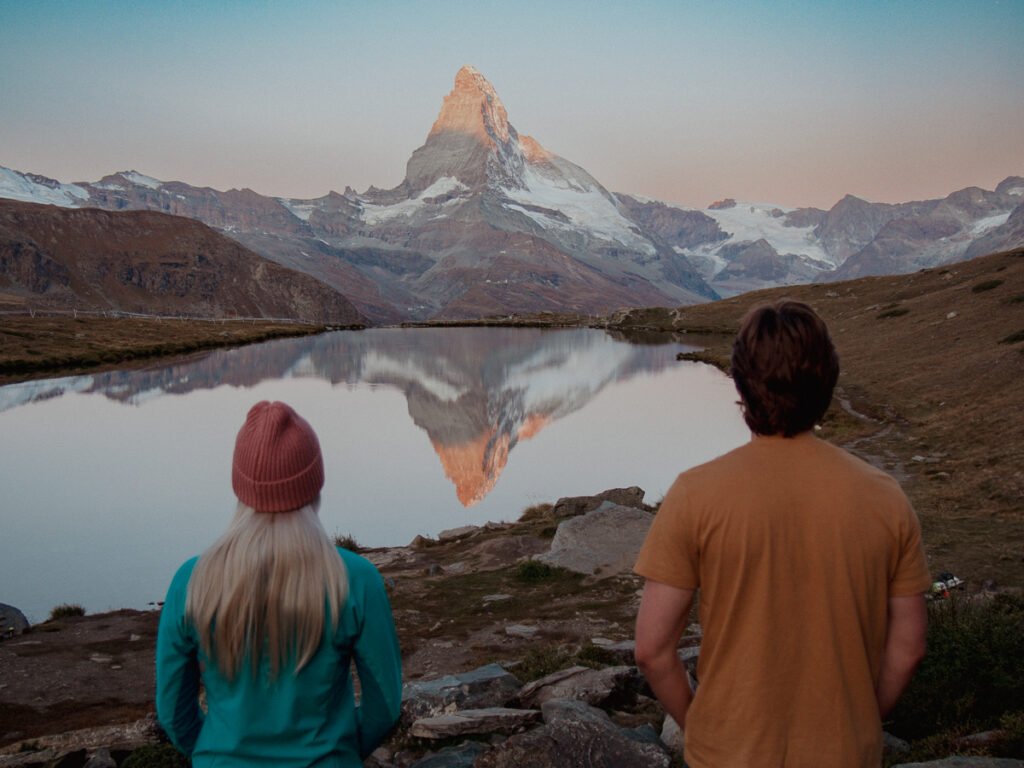
Key Takeaways
✦ 3-4 days hits the sweet spot for those who are short on time. Zermatt has plenty to explore, even for non-skiers, the more time you have the better.
✦ The main highlights are The Matterhorn, Sunnegga, Gornergrat, Glacier Paradise, Bahnhofstrasse & Hinterdorfstrasse.
✦ Zermatt is a car free village, easily accessible by train. Drivers must park their car in Täsch.
Discover Zermatt contains affiliate links, if you make a purchase using one of these links, we may receive compensation at no extra cost to you. Read our disclaimer for more information.
How Many Days Do You Need in Zermatt?
Here’s the deal. The number of days you need in Zermatt depends on your travel goals. Are you here for an adrenaline rush or to kick back with a mug of glühwein and Instagram-worthy views?
Ideally, the more time the better, but we understand that time and money are of the essence. For most people, three to four days hit the sweet spot.
This time allows you to fit in some exciting activities and account for potentially cloudy days. It would be a bummer if you travelled all the way to Zermatt and didn’t see the Matterhorn.
But even if you only have a day or two to spare, we can help you plan a relaxed highlights tour or a jam-packed must-see itinerary.

Booking Your Holiday?
Use our favourite travel resources to save time & money:
Best Accommodation Deals
Save on Swiss Train Travel
Affordable Airport Transfers
Excellent Tours & Activities
The best Flight Deals
Save on Car Hire
Don’t forget Travel Insurance
When is the Best Time to Visit Zermatt?
The main attractions can be visited 365 days a year, including a small glacial area for year-round skiing. The best time to visit will depend on your travel preferences.
December to April is best for the main ski area. January and March are the quietest, and April is the warmest, offering an outstanding balance of snow sports, a lively atmosphere and springtime blooms.
If a Narnia-like wonderland is on your travel bingo card, early winter is the time to visit Zermatt. Snowfall can be unpredictable, but if you’re looking for snow-covered mountain huts and twinkly lights, December to February is your best bet.
June through August are the peak summer months. If you want green fields teeming with flora and fauna, the warmest temperatures and the most open hiking trails, mountain biking routes, lifts, and restaurants, this is the time for you.
September and early October are ideal for those seeking fewer crowds, mild temperatures and my favourite–autumn foliage.
May and November are usually the wettest months, but they are also the quietest. If you’re looking for peace and quiet and a great deal on accommodation, this is the best time to visit Zermatt.
Be aware that some accommodations, activities and restaurants close from early May to mid June and mid October until late November. Make sure to check any desired options to avoid disappointment.
For a more detailed breakdown, head to:
Zermatt’s Main Highlights
The Matterhorn is the biggest draw for visitors to Zermatt and can be seen from most places in town and the mountain area. At 4’478 m (14’692 ft), the Toblerone mountain sits on the border between Switzerland and Italy and is known by many names, including Hörnli, The Horn, Cervino, and Mont Cervin.
Three main mountain areas make up sightseeing, nature walks, hiking, climbing, mountaineering, mountain biking and skiing locations in Zermatt.
Matterhorn Glacier Paradise sits on Klein Matterhorn at 3’883 m (12’740 ft) and is best for panoramic views of the Alps, glacial skiing, and challenging hiking and mountain biking routes.
Gornergrat is the place for a scenic railway journey, Riffesee Lake, the Gorner Glacier and climbing at Riffelhorn.
Sunnegga is known for its long sunshine days, lunching in Findeln, Stellisee Lake, the 5 Lakes Trail and the summit of Rothorn at 3’103 m (10’180 ft).
All three areas offer easy-to-expert hiking in the summer and skiing in the winter.
Zermatt Village is a highlight in itself, the classic Swiss buildings, cobbled streets and seasonal flora make this enchanting alpine village come alive.
Bahnhofstrasse, Zermatt’s lively main street, runs from the train station to the town square and is lined with inviting cafes and classic alpine buildings. For a closer look at the town’s history, wander down Hinterdorfstrasse, a preserved slice of the past.
Another key area during the peak summer months is Höhbalmen, which offers various challenging hikes and summits with excellent mountain hut lunch stops. Explore this area if you’re up for a challenge and want to avoid the crowds.

Money Saving Tips and Passes in Zermatt
We hear ya, Zermatt is not a budget destination, and your itinerary may well depend on your available spends. Here are a few money-saving passes and tips to help your wallet stretch that little bit further when visiting Zermatt:
Saver Day Pass or SBB Super Saver Train Tickets: This pass allows you to travel to Zermatt village, but it doesn’t cover mountain transport like the Gornergrat railway. It’s a good option for those planning to explore the village and surrounding areas.
Swiss Travel Pass: Offers 50% off on the Gornergrat ticket and other mountain transport. It’s ideal for travellers planning to explore multiple regions in Switzerland.
Half Fare Card: Provides 50% off on all tickets, including mountain railways and cable cars in Zermatt. This can be a cost-effective option if you use public transport extensively.
Peak Pass: Offers unlimited travel on all lifts and trains, including the Sunnegga area, Gornergrat and Matterhorn Glacier Paradise, excluding the Alpine Crossing. This can be for consecutive or flexible days, i.e. 3 in 5 days. Not valid for skiing.
If you plan to visit all three mountain areas in Zermatt within two days, the peak pass is by far the most cost-effective, if you also have the Swiss Travel Pass, you will save an extra 25%.
Peak2Peak: Allows you to explore two of the area’s most iconic viewpoints: the Matterhorn Glacier Paradise and Gornergrat, all in a single excursion. This pass will give you a comprehensive experience of Zermatt’s stunning alpine scenery.
Budget-Friendly Activities | Consider exploring free or low-cost attractions like Zermatt Village, the Matterhorn Museum and Gorner Gorge. Also, any hiking trails accessible from Zermatt which are suitable for your fitness level.
Take a one-way ticket to Sunnegga, Rotenboden or Gornergrat and walk back to Zermatt via one of the many hiking trails in summer.
Ski passes are the most expensive in December and January, reducing slightly in February and March. April is the least expensive time to ski and snowboard, with tickets starting at 88.00 CHF.
Getting to Zermatt
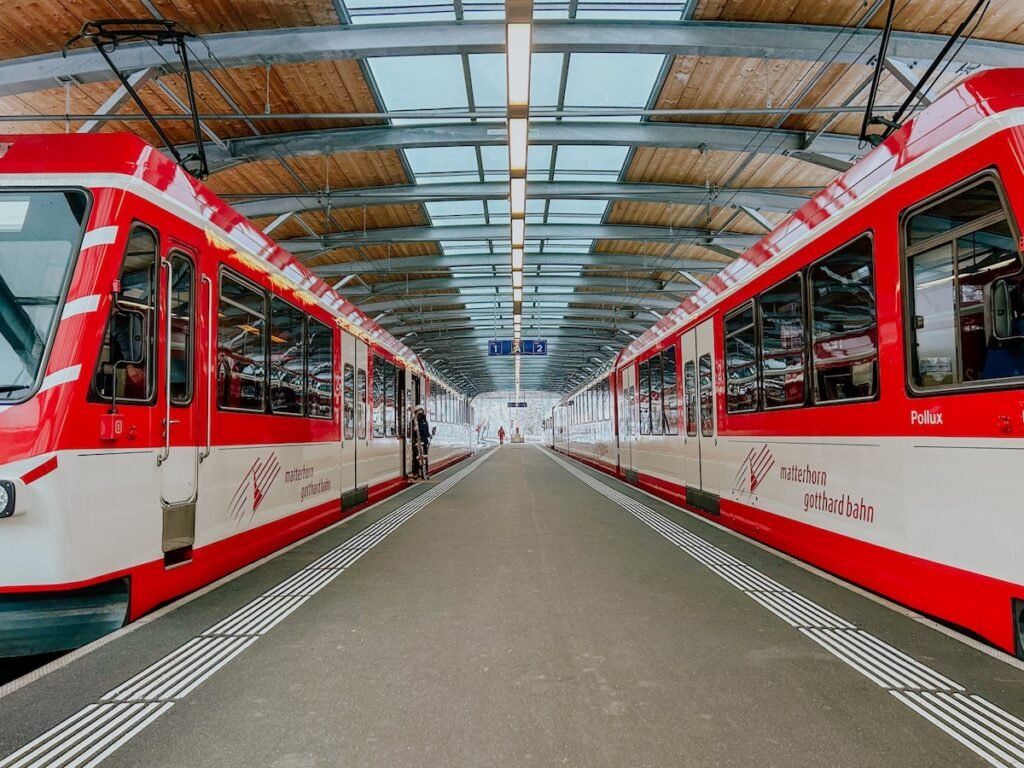
Here are the journey times to get to Zermatt from various nearby destinations and airports, including driving and train options:
Geneva
Train: Approximately 3 hours 31 minutes to 4 hours 5 minutes.
Driving: Around 3 hours.
Zurich
Train: About 3 hours 15 minutes to 3 hours 44 minutes.
Driving: Approximately 4 hours.
Basel
Train: Around 3 hours 10 minutes to 3 hours 39 minutes.
Driving: Approximately 3 hours 30 minutes.
Bern
Train: Approximately 2 hours 7 minutes.
Driving: Around 2 hours 30 minutes.
Milan
Train: About 3 hours 37 minutes.
Driving: Approximately 3 hours 31 minutes.
Sion
Train: Around 1 hour 50 minutes to 1 hour 59 minutes.
Driving: Approximately 1 hour 30 minutes.
Interlaken
Train: Approximately 2 hours 40 minutes.
Driving: Around 2 hours 15 minutes.
Grindelwald
Train: About 2 hours 57 minutes to 3 hours 14 minutes.
Driving: Approximately 3 hours.
Lucerne
Train: Approximately 3 hours 30 minutes.
Driving: Around 3 hours 45 minutes.
Verbier
Train: Approximately 2 hours 30 minutes.
Driving: Around 1 hour 45 minutes.
Laax
Train: Approximately 4 hours.
Driving: Around 3 hours 30 minutes.
These approximate times can vary based on traffic conditions and specific train schedules. Hire a private transfer from Kiwi Taxi.
Although people tease about Swiss timekeeping, it’s really not a joke. Swiss trains are super efficient, and when something goes wrong, they usually have a backup plan pretty swiftly.
As Zermatt is a car-free village, drivers will park at Täsch and take the short 12-minute shuttle train to Zermatt.
For more information, here’s our guide on:
One Day in Zermatt Itinerary
If you’re short on time and Zermatt is a one-day stop on your Switzerland itinerary, let’s ensure you hit those must-see spots. Whether you arrive early in the morning or at lunchtime, you should be able to squeeze at least two of the main highlights into your day.
For a jam-packed Zermatt itinerary, we would advise taking a packed lunch for the gondola, or train or as a mountainside picnic. If you have time in the evening, indulge in one of Zermatt’s award-winning restaurants.
For the more leisurely paced traveller, choose one of these main highlights with a lunch stop. The restaurants in Zermatt are an attraction of their own, and with many boasting Matterhorn views, what more could you want?
Matterhorn Glacier Paradise

What’s so special about Matterhorn Glacier Paradise?
It is the highest lift station in Europe at 3’883m on the Klein Matterhorn mountain. For mountain lovers, the 360º view of 38 four-thousand-metre peaks and 14 glaciers across the Swiss, French and Italian Alps is breathtaking at any time of the year.
For Non-Skiers and Sightseers
Take in the incredible vistas from the viewing platform, and if you have plenty of time, roam through a glacier, peek at ice sculptures and ride the ice slide at the Glacier Palace. There’s also a restaurant with large windows, which makes a great place to warm up with a coffee and a snack.
For Skiers and Snowboarders
During winter, you can clip in and ride the 16km route back to Zermatt, descending from 3’883m to 1’620m on Blue, Red, and Black slopes.
In summer, the glacial skiing area opens from around 7:00 a.m. to 12:00 p.m., but this can vary daily depending on conditions. Plateau Rosa has a beginner’s area, Red and Blue slopes, and a Snowpark.
For Mountaineers
Breithorn is one of the easiest 4000 m peaks to summit and can be comfortably achieved in a morning via Matterhorn Glacier Paradise. One summer, we summited Breithorn on a -5ºC morning and were eating Ice Cream in a baking 27ºC Ticino by late afternoon.
Be mindful of the weather, if you’re bound to one day, it may not be the best conditions to summit, inexperienced climbers should hire a local guide from Zermatters.
For Mountain Bikers

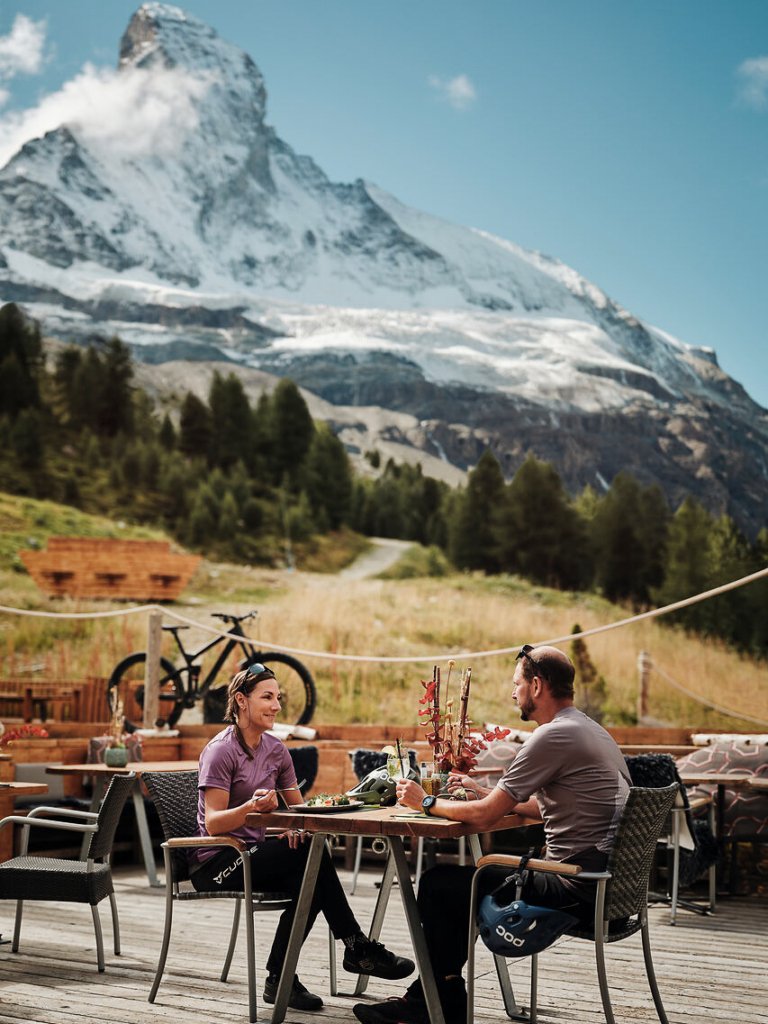
Ride the gondola with your bike to the Trockernesteg station. Leave your bike here and then jump on the gondola to explore Matterhorn Glacier Paradise. Return for the Trockenersteg to Furi trail, a fun and challenging route for experienced mountain bikers in the summer.
Tips
Whether on foot or skis, the Matterhorn Glacier Paradise is best early in the morning at any time of year. For crisp temperatures and cloudless views, mornings are your best bet. Although, cloud free mountains can never be guaranteed.
The air is cold and thin up here! Wear plenty of warm layers and take your time, it’s not unusual to be a little short of breath on your first visit.
Upgrade your ticket for the Crystal Ride and enjoy a glass-bottom gondola for the final connection to the Matterhorn Glacier Paradise.
On the way back down, stop off at Schwarzsee for the Zermatt sign and up-close views of the Matterhorn. In summer, take a short walk to Schwarzsee Lake.
While the views from Matterhorn Glacier Paradise are stunning, I prefer to gawp at the view from Testa Grigia. During winter, ski or snowboard to Plateau Rosa and stop off at Rifugio Guide del Cervino (also known as Testa Grigia), grab a drink and soak in that south-facing sunshine over the Italian Alps.
Note: This is a steep red run unsuitable for beginners.
You can also take the Alpine Crossing from Matterhorn Glacier Paradise to Plateau Rosa, although it will cost you a pretty penny for the privilege. This is also perhaps not something for a rushed schedule.
Getting There
You can either walk or take an E-Bus to the Matterhorn Express Station, ride the gondola to Trockenersteg, and then change to connect to the Matterhorn Glacier Paradise.
The journey takes around 40 minutes from the Matterhorn Express Station in Zermatt to the Matterhorn Glacier Paradise.
Ticketing
Tickets can be purchased online or at the Matterhorn Express Station, starting at 95.00 CHF, without discounts. A ski pass starting at 88.00 CHF includes Matterhorn Glacier Paradise but not entry to the Glacier Palace.
Standard Ticket Includes
- Complimentary local bus service
- A round-trip journey to the Matterhorn Glacier Paradise, with optional stops at stations along the way
- Bike transport included up to Trockener Steg
- Access to the Glacier Palace, a stunning ice wonderland
- Entry to the viewing platform and the Cinema Lounge (subject to the schedule)
- Free travel for dogs
- Admission to the 3S InfoCube, an educational experience about the world’s highest cableway
Where to Eat Lunch

If you have time for a lunch stop between Matterhorn Glacier Paradise and Zermatt, these are our favourite places:
During winter, ski via Schwarzsee on Piste 51 to join Piste 52 for:
Restaurant | Stafelalp
Location | Piste 52 Stafelalp
Food | Traditional and Modern Swiss Dishes
Best For | Hearty dishes and a unique Matterhorn view
Note: The piste from Stafelalp to Furi is steep and narrow; we would recommend this to experienced and confident skiers only.
Hop off the lift at Furi in summer or ski or snowboard in winter to:
Restaurant | Marmo
Location | Furi
Food | Local and International Creative Dishes
Best For | Excellent Food and Service
Ski or snowboard in winter or disembark the lift at Furi in summer and take a short walk to Zum See for:
Restaurant | Zum See
Location | Zum See (between Furi and Blatten)
Food | Traditional Swiss Dishes
Best For | Mountain Hut Setting
Many mountain restaurants may be closed if you’re travelling in the off-season of late Spring or Autumn. You will find plenty of places to eat in Zermatt village.
Here’s our guide to:
The Best Restaurants in Zermatt
Where to Après Ski
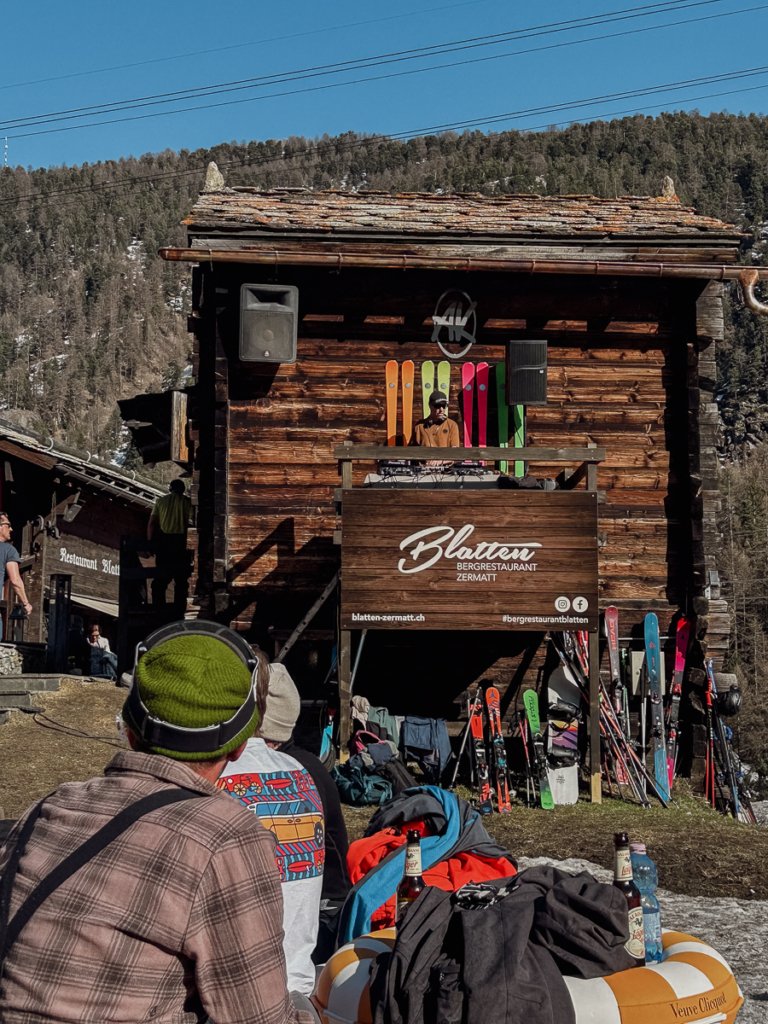
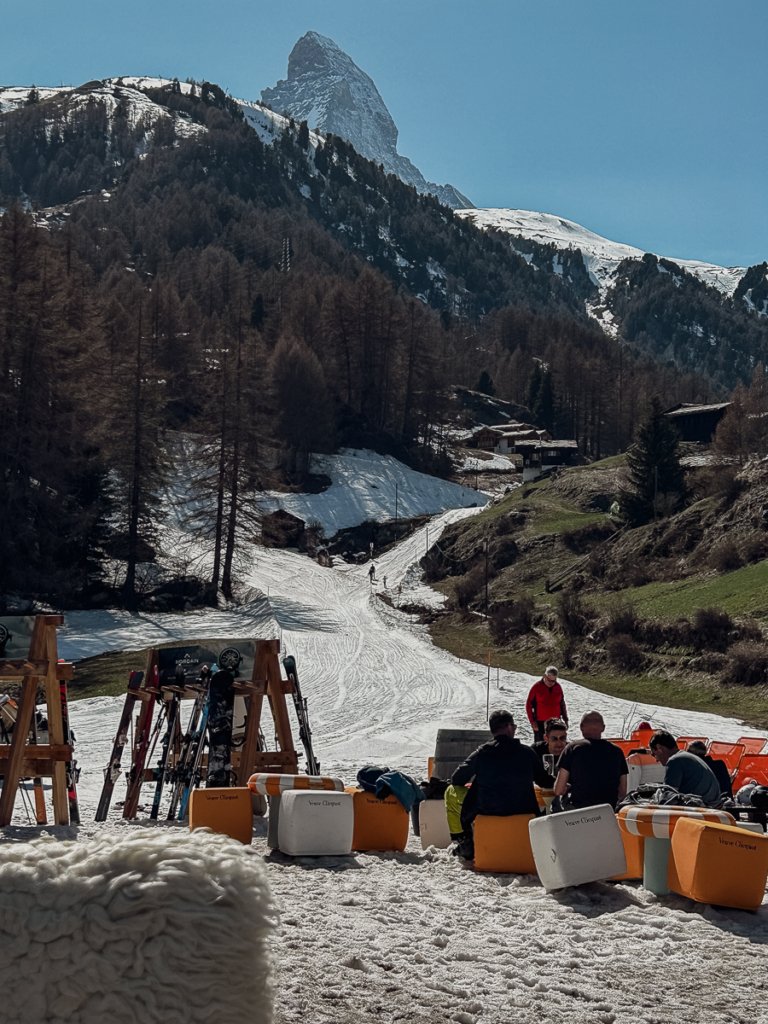
In winter, on the way down from Matterhorn Glacier Paradise, you’ll find the best après ski spots at:
Venue | Restaurant Blatten
Opening Times | 9:30 am – 6:00 pm
Location | Blatten 50–Red Slope. Blatten
Vibe | Mountain hut cosiness inside and famous shots of Schümli Pflümli. Deck chair seating outside for beers & cocktails as the sun sets behind the Matterhorn.
Venue | Hennu Stall
Opening Times | 2:00 pm – 8:30 pm
Location | Blatten 50–Red Slope. Blatten
Vibe | DJ sets playing Euro Pop, table dancing, ski boot shuffling and shot drinking raucousness.
Venue | Schmuggler-Höhle
Opening Times | 2:00 pm – 12:00 am
Location | Schluhmattstrasse 50, Zermatt
Vibe | A few steps from the end of the piste, with deck chairs to watch the sunset behind the Matterhorn and often live music.
Note: Blatten 50 can be challenging towards the end of the day, the piste is steep and bumpy in parts, take care on the descent, especially after a few drinks.
Gornergrat

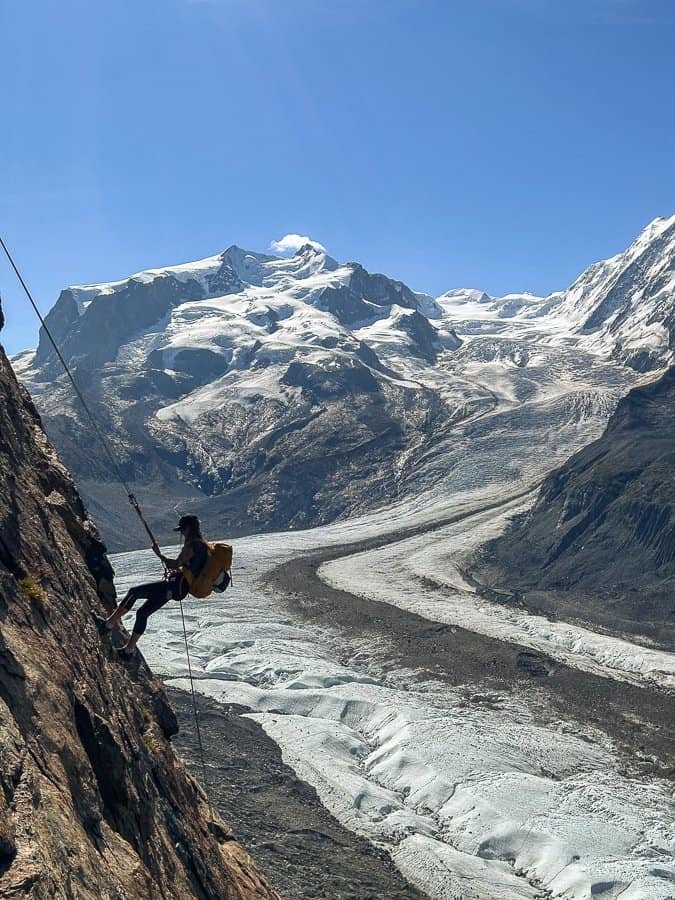
What’s so special about Gornergrat?
At 3,089 meters above sea level, it boasts of being one of Europe’s highest open-air cog railways. The journey itself offers scenic views over Zermatt. Once you reach Gornergrat, you can take in the Gorner Glacier and panoramic views of over 29 four-thousand-metre peaks, including the iconic Matterhorn.
For Non-Skiers and Sightseers
Take in the stunning views as the Gornergrat Railway winds above Zermatt through the trees and the meadows that become snow-dusted ski fields in winter. Enjoy the Gorner Glacier and panoramic views at the top.
During summer, stroll to Riffelsee Lake from the Rotenboden station and snap a Matterhorn reflection. If you have time and are up for a more strenuous hike, take the trail back down to Riffelberg or Zermatt. Then, reward yourself with a relaxing drink and a sunset behind the Matterhorn.
For Skiers and Snowboarders
During winter, Gornergrat is home to some nice, wide, cruisey Blue and Red Pistes. Visit the Iglu Dorf (Igloo Village), stop at Alphitta and ride back to town via the mixture of challenging runs.
At Riffelberg you’ll also find the Swiss Snow School’s beginner area.
For Climbers
Riffelhorn offers beginner sport climbing routes, and more challenging muti-pitch climbs. With easy access from Rotenboden station and a stunning backdrop, Riffelhorn is a dream for any climber. As a relatively small mountain, all routes could be completed within half a day.
For Mountain Bikers
The Gornergrat Railway no longer allows mountain bikes to ride on the train. You can still access the lower routes from Riffelberg by taking the Gondola from Furi.
Tips
Riding the scenic train to or from Gornergrat is all part of the experience. Suppose you start the day at the Matterhorn Glacier Paradise during winter and peak summer months.
In that case, you can access Gornergrat quicker by taking the Gondola from Furi to Riffelberg, but you will miss out on a large portion of the scenic train unless you take the train back to Zermatt.
For Matterhorn views, sit on the right side of the train going up to Gornergrat and the left down to Zermatt.
The train starts at 7:00 am, the earlier you go, the less crowded it will be. For later journeys and good seats, consider priority boarding.
On a clear day, Photographers will want to get to Riffelsee as early as possible for still Matterhorn reflections and no crowds. Make Rotenboden your first stop on the way to Gornergrat.
Live music and après ski lovers should check the schedule for what’s on at Alphitta or go back to town via Furi and stop at Blatten, Hennu Stall or Schmuggler Höhle.

Getting There
The Gornergrat Railway station, opposite the Zermatt railway station, can be reached by foot, bicycle, E-Bus, or E-Taxi. You can also access the Riffelberg Station via the Furi-Riffelberg Gondola (Riffelberg Express).
Ticketing
Tickets can be purchased online or at the Gornergrat Railway Station. They start at 48.00 CHF for one way to or from Gornergrat, without discounts.
A one-day Zermatt Ski pass includes the Gornergrat Railway.
Standard Ticket Includes
- A one-way or round trip to the station of your choice
- Complimentary local bus service
- Free travel for dogs
Where to Eat Lunch
If you have time for a lunch stop between Gornergrat and Zermatt, these are our favourite places:
At any time of year, you can take the Gornergrat Railway to:
Restaurant | 3100 Kulm Hotel
Location | Gornergrat
Food | Local and International Dishes
Best For | Panoramic Views
You can ski in winter, walk in summer or take the train to:
Restaurant | Alphitta
Location | Riffelalp (on Gornergrat Railway Line)
Food | Hearty Swiss and European Dishes
Best For | Matterhorn Views and Live Music (check schedule for live music)
During winter, you can ski or snowboard to:
Restaurant | Iglu Dorf
Location | Iglupiste 45–Blue Slope
Food | Fondue and Bar Snacks
Best For | Igloo Village and Outdoor Fondue
Where to Après Ski
With Gornergrat being centrally located, you can access all of the Après Ski locations relatively easily. Skiing or snowboarding to Zermatt via Furi gives you easy access to all of the après ski available in Gornergrat, Furi and Southern Zermatt.
Taking the train back to the main station gives you easy access to all of the après ski available in Zermatt town.
Sunnegga

What’s so special about Sunnegga?
Zermatt receives over 300 sun-baked days per year, and with Sunnegga being an elevated south-facing area, it’s no wonder its name translates to Sunny Corner. With a wide array of trails, pistes, lakes and restaurants, exploring Sunnegga is full of endless possibilities.
For Non-Skiers and Sightseers
Enjoy the stunning views from Rothorn, and eat at one of the famous restaurants in Findeln. All restaurants are accesible by lifts or walking paths in winter.
In summer, take on the 5 Lakes Trail and snap Matterhorn reflections at Stellisee Lake. Leisee Lake is also kid-friendly, with a small playground and barbecue facilities.
Take a leisurely stroll along one of the scenic hiking trails, such as the Flower Walk, a short and easy route showcasing alpine flora. For those interested in wildlife, the marmot trail offers the chance to observe these adorable creatures in their natural habitat.
If you’d like a full day of hiking, one of my favourite routes is taking the 5 Lakes Trail to Moosjisee and switching to the Nature Trail to Riffelalp. The terrain and Matterhorn views along this route are unique, and it’s often a much quieter trail.
Switching to the Nature Trail would miss out on Leisee Lake at Sunnegga, but this could easily be done as a stop-off on the way up towards Rothorn in the morning if you really wanted to see all five lakes.
For Skiers and Snowboarders
Sunnegga forms part of the Rothorn ski area, making it an excellent base for riders of all abilities. Board the gondola to Blauherd and explore a network of Blue, Red, and Black runs. A favourite is the long Red slope down to Patrullarve, offering sweeping Matterhorn views.
For beginners, Wolli’s Park is a gentle, protected area perfect for learning to ski. It features magic carpets and wide-open, uncrowded slopes. Advanced riders can enjoy off-piste opportunities and challenging Red and Black runs leading toward Zermatt.
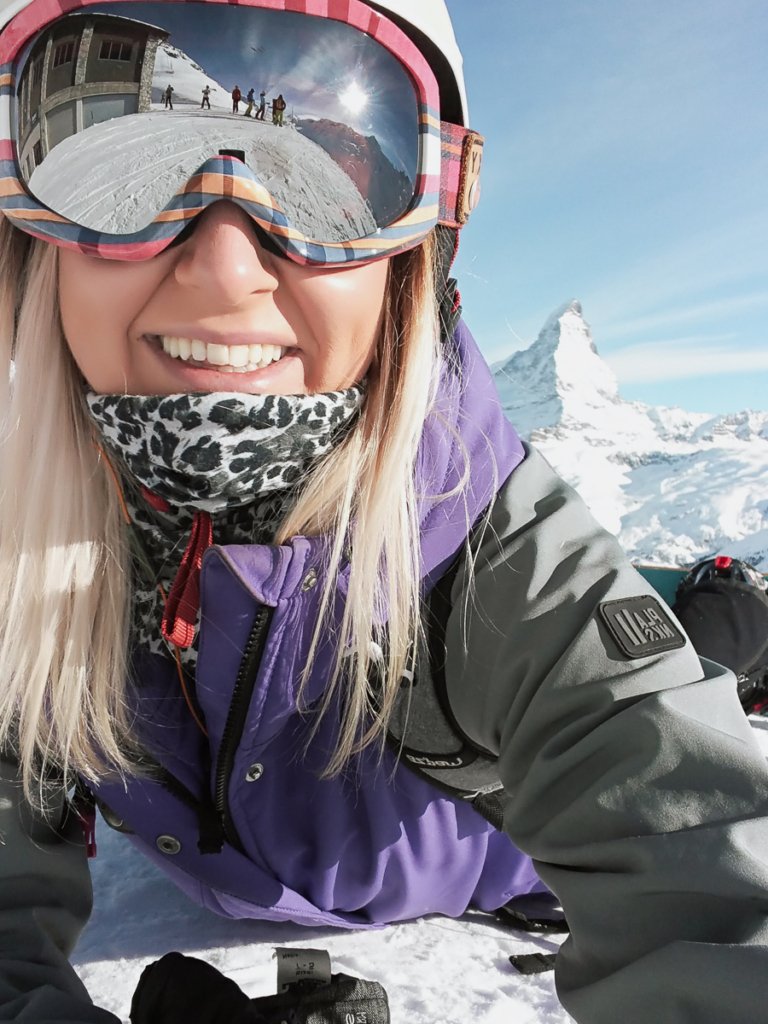
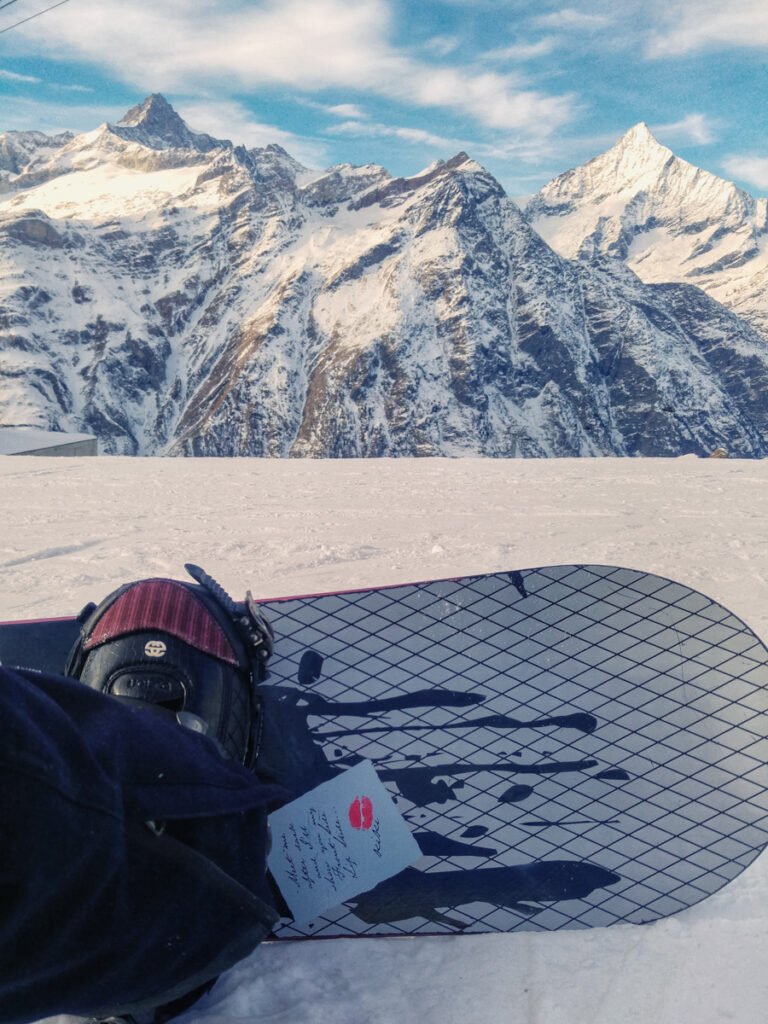
For Climbers
Fluhalp is a hidden gem for sport-climbing enthusiasts in the summer. This spot boasts a small climbing area with routes up to a 6b difficulty level, it’’s perfect for climbers of all ages and skill levels, all set against a stunning alpine backdrop and insane Matterhorn views.
For Mountain Bikers
In summer, Sunnegga features some of the most thrilling mountain biking trails in the Zermatt area. Riders can take the funicular to the top and choose from routes of various difficulty levels.
The trail from Sunnegga down to Zermatt offers fast descents, tight turns, and stunning Matterhorn views. For an adrenaline-pumping ride, try the Flow Trail—a smooth, modern trail with berms and rollers, perfect for intermediate and advanced riders.
Tips
Pack a lunch or snacks in summer to enjoy by Leisee Lake—it’s a serene spot perfect for a mid-day break.
Watch for wildlife like marmots and mountain goats, often spotted during the summer.
Photographers hoping to get sunrise or sunset shots of the Matterhorn from Stellisee should consider staying overnight at Fluhalp. Check out the night sky while you’re up there, you won’t be disappointed on a clear night.
Families will love Wolli’s Park, where small and big (adult-sized) kids can safely learn to ski in winter.
Getting There
Sunnegga is easily accessible via the Sunnegga Express funicular from Zermatt village. The underground funicular takes just 4.5 minutes to whisk you up to this sunny plateau. Once at Sunnegga, connections to Blauherd and Rothorn gondolas make it easy to explore further.
Ticketing
Tickets can be purchased online or at the Sunnegga station. A round-trip ticket starts at 45.00 CHF for adults. The Sunnegga station is included in the Zermatt Ski Pass, making it convenient for skiers and snowboarders.
Standard Ticket Includes
- Round-trip funicular ride to Sunnegga
- Complimentary local bus service
- Free travel for dogs
Where to Eat Lunch
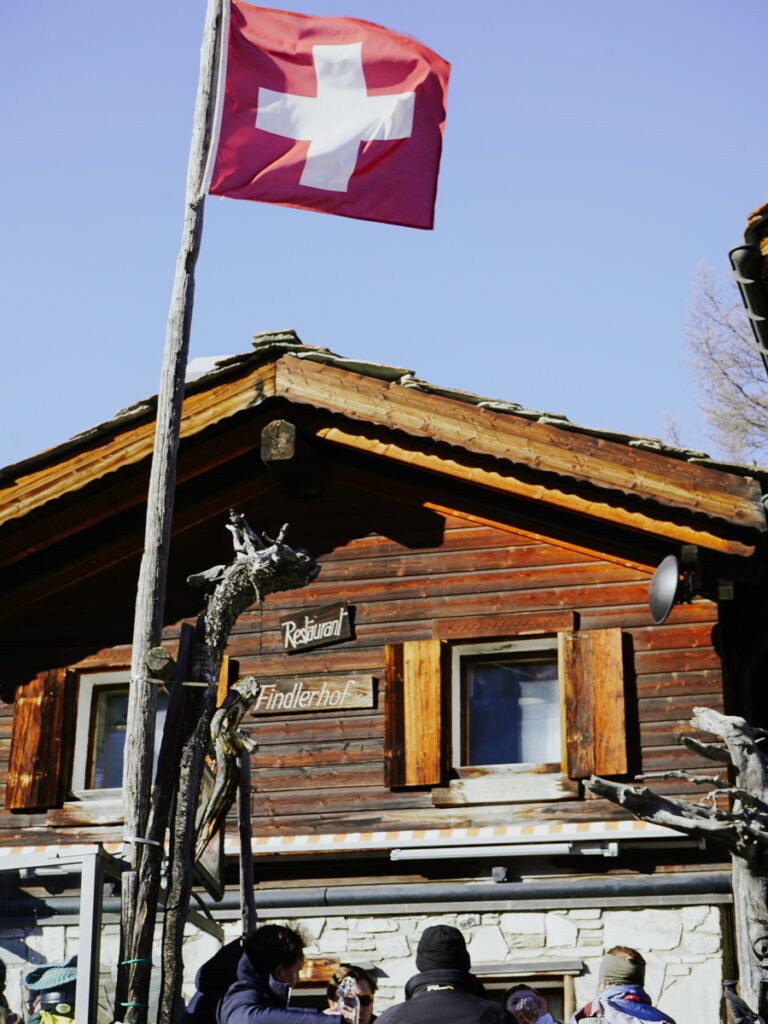
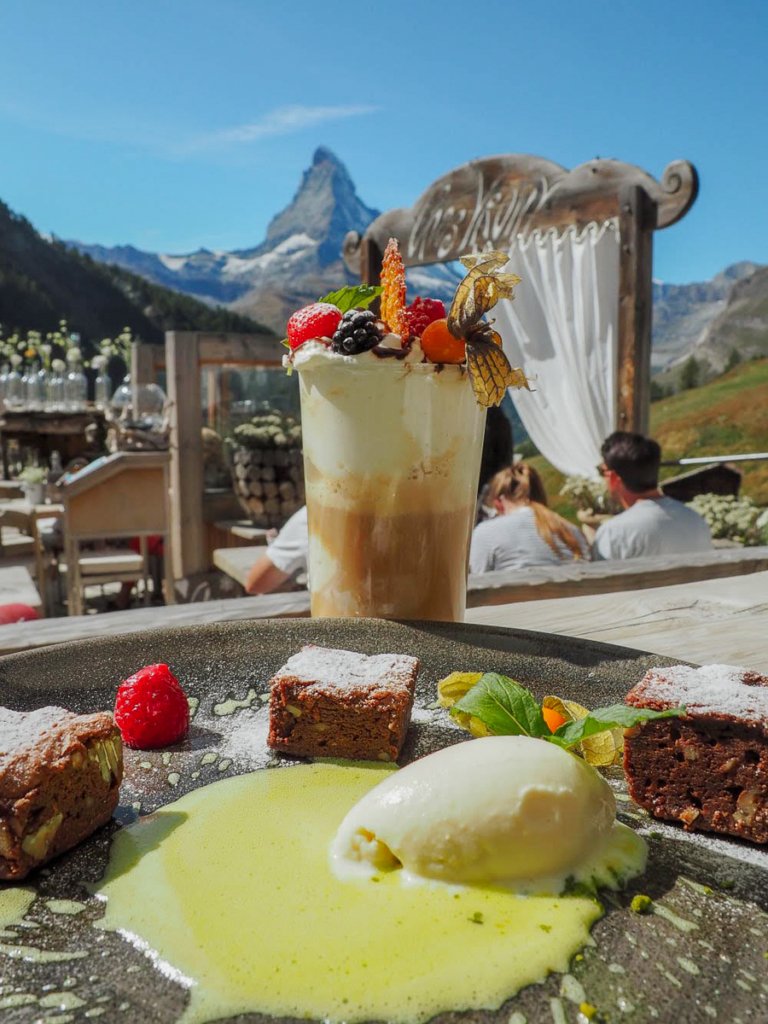
Sunnegga offers many popular eateries with fantastic food and views. Here’s where to consider stopping for a meal:
Restaurant | Findlerhof
Location | Findeln Village. Easy Run 6–Blue Slope in winter.
Food | Traditional Valais fare and creative dishes.
Best For | Romantic meals with stellar mountain vistas.
Restaurant | Bergrestaurant Paradise
Location | Trail from Sunnegga to Findeln. Easy Run 6–Red Slope in winter.
Food | Traditional hearty Swiss specialities.
Best For | A warm, welcoming atmosphere and excellent fondue.
Restaurant | Chez Vrony
Location | Trail from Sunnegga to Findeln. Easy Run 6–Blue Slope in winter.
Food | Gourmet dishes, including homemade sausages and rösti.
Best For | Luxury setting, authentic Swiss cuisine and panoramic Matterhorn views.
Where to Après Ski
For après ski on the Sunnegga side, here are our top picks:
Venue | Blue Lounge
Opening Times | 10:00 am – 4:00 pm
Location | Blauherd
Vibe | Chill-out space with live Musicians or DJs and breathtaking Matterhorn views.
Venue | CERVO Mountain Resort
Opening Times | Monday – Thursday, 3:00 pm – 6:00 pm, Friday – Sunday, 3:30 pm – 6:30 pm
Location | End of Howette 3–Red Slope, Zermatt
Vibe | Trendy après ski with a mix of hearty snacks, cocktails, and live music.
Venue | Adler Hitta
Opening Times | 9:00 am – 6:00 pm (seasonal hours may vary)
Location | Between Sunnegga and Findeln, accessible via the slopes or hiking trails.
Vibe | Deep house DJs and performances from violinists or saxophonists.
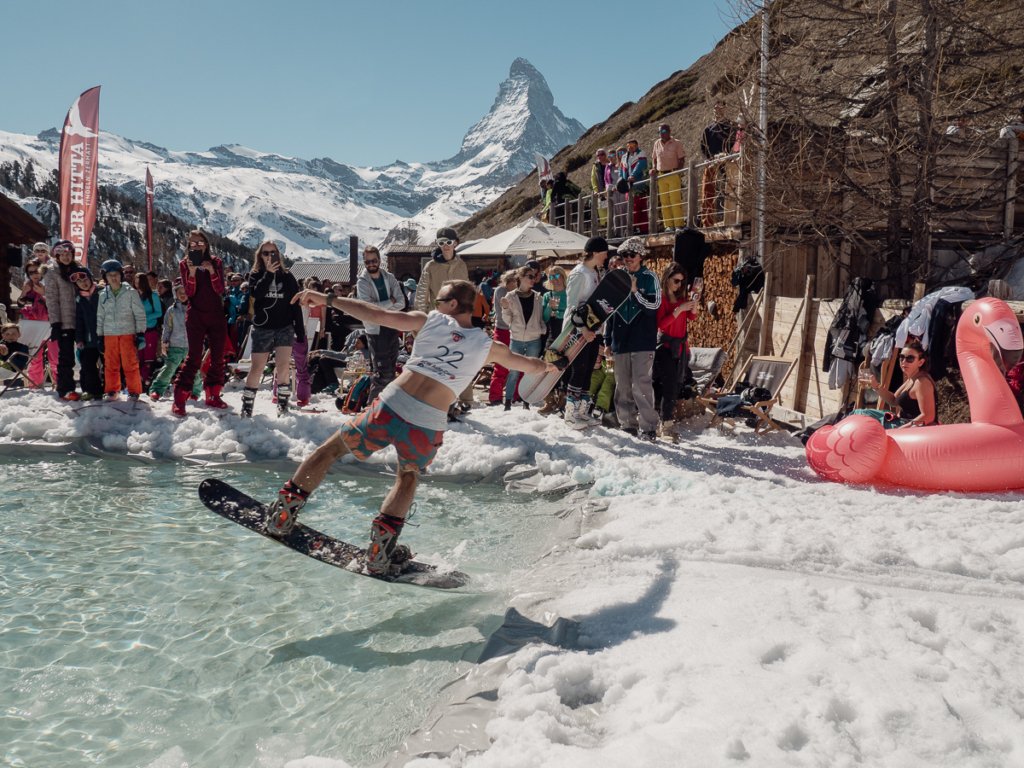
The lift from Eja (below Findeln) closes at 4:00 pm. Be wary of this if you plan to ski back to Zermatt from Adler Hitta or any other restaurant in Findeln. It’s a long walk uphill with ski gear if you miss it.
Note: the slopes back to Zermatt from Sunnegga can be challenging toward the end of the day, especially if they become icy or crowded. Ried 2 slope is a little more forgiving than Untere National 1.
Zermatt Village
What’s so special about Zermatt Village?
Zermatt Village is where tradition meets adventure, tucked in one of the most stunning alpine settings in the world. With cobblestone streets, no cars to clog the air, and the mighty Matterhorn looming above, this village invites you to slow down, breathe in that fresh mountain air, and explore its quirky corners.
Bahnhofstrasse
Consider Bahnhofstrasse the beating pulse of Zermatt. This lively main street has it all, from luxury boutiques for a Swiss watch splurge to coffee spots where you can unwind with a latte and a local pastry. Don’t miss grabbing some fresh-baked bread or artisanal chocolate.
Hinterdorfstrasse
For a glimpse of Zermatt’s past, head to Hinterdorfstrasse. The 16th-century wooden chalets along this quiet lane transport you back to simpler times. These historic buildings, elevated on stilts, are framed by flower boxes in summer and snow in winter, making this one of the most picturesque spots in town.

Kirchbrücke
Kirchbrücke is more than just a wooden bridge—it’s a front-row seat to one of the best views of the Matterhorn. Whether bathed in orange at sunrise, surrounded by pink clouds at sunset, or towering under a clear blue sky, the Matterhorn from Kirchbrücke will leave you speechless.
Mountaineers’ Cemetery
Quiet but powerful, the Mountaineers’ Cemetery is a tribute to climbers who bravely ventured into Zermatt’s extraordinary peaks and didn’t return. Wander through and read the plaques for a humbling moment of reflection. You’ll gain a new appreciation for the Matterhorn’s beauty and its challenges.
Zermatlantis

Want to dig deeper into Zermatt’s story? Zermatlantis, the Matterhorn Museum, does exactly that. It’s an underground adventure where you can peek inside life-sized replicas of alpine homes and farmhouses, and relive the first ascent of the Matterhorn.
Tips
Wear comfy shoes. Between cobblestones and plenty of walking, you’ll want to stay comfortable while exploring this pedestrian-friendly village.
Bring a reusable water bottle—you’ll find fountains all around the village with pristine glacier-fed water.
Stop by the Kirchbrücke early in the morning or near sunset for the Matterhorn in the best light.
Consider a guided village tour to learn about Zermatt’s history and hidden gems you might otherwise miss.
Where to Eat
The choices for lunch and dinner are endless in Zermatt, here are a few of our favourites:
Restaurant | Schäferstube
Location | Oberdorfstrasse 26, near Kirchbrücke
Food | Swiss classics, with lamb straight from the family farm
Best For | A cosy alpine experience and excellent meat fondue
Restaurant | Du Pont
Location | Gornergratstrasse 1, by the church square
Food | Traditional Swiss dishes, including some of the best rösti in town
Best For | A traditional lunch or dinner that won’t disappoint
Restaurant | SayCheese
Location | Grand Hotel Zermatterhof
Food | Decadent Swiss raclette and fondue
Best For | Cheese lovers, date nights, or celebrations
Where to Après
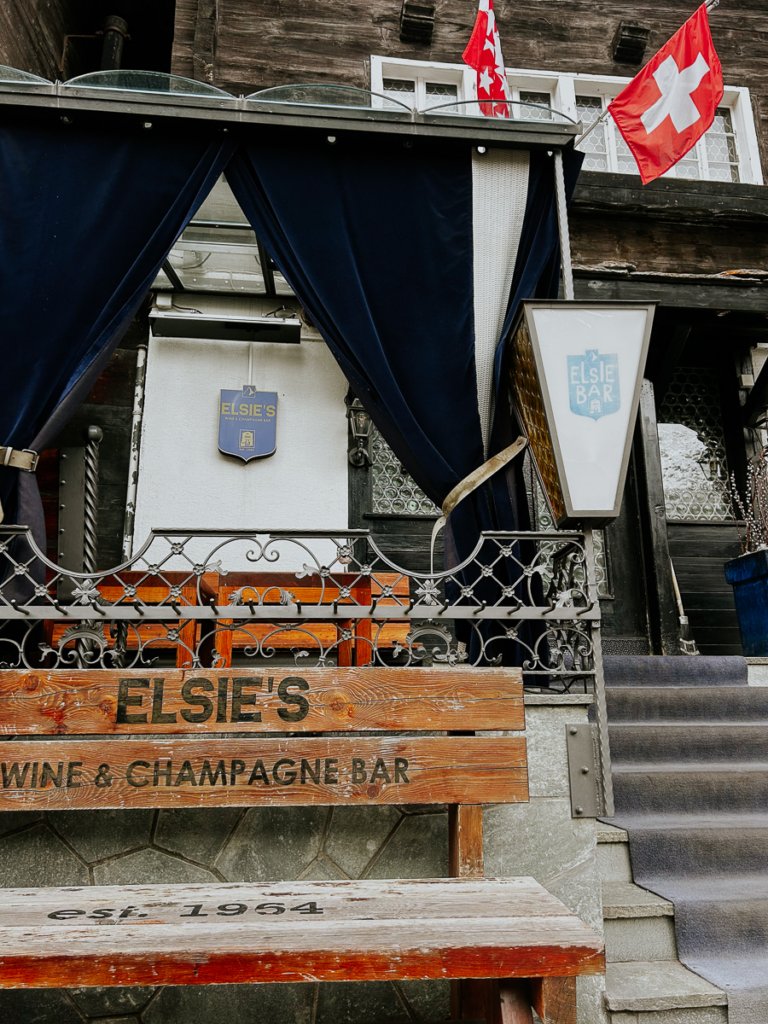
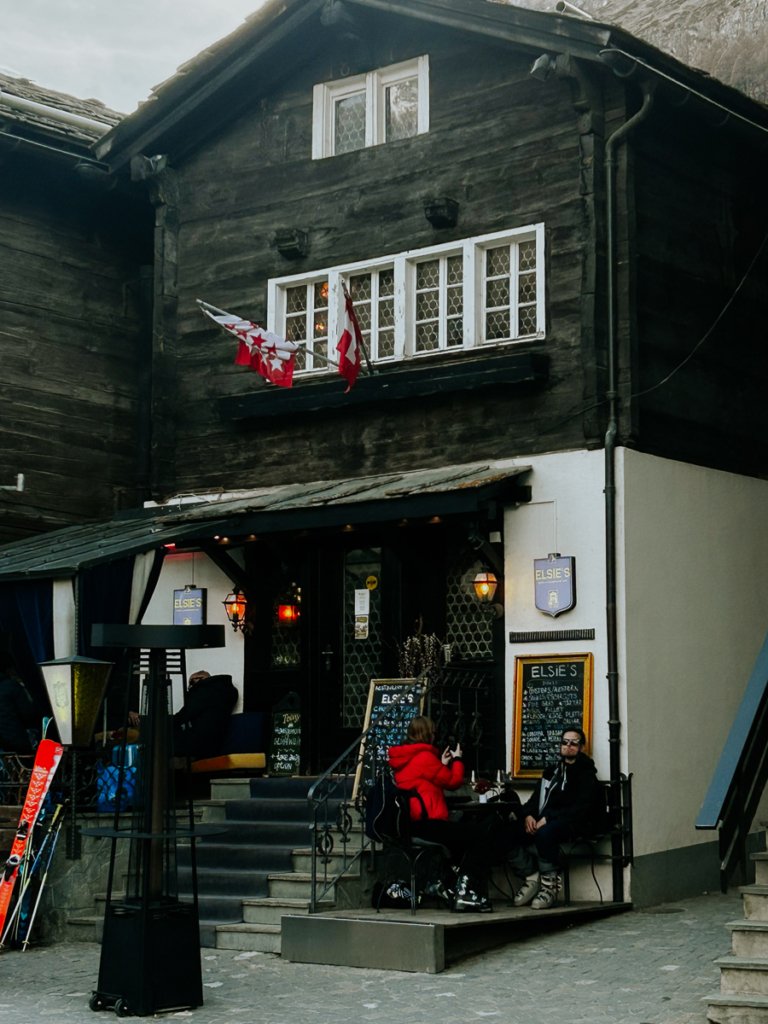
From boutique wine bars to lively bands, there’s no shortage of choice in Zermatt Village for après ski, here are some of our faves:
Venue | Elsie’s Bar
Opening Times | 3 pm – 12 am
Location | Kirchplatz
Vibe | An intimate, old-school wine bar with a classy cocktail list.
Venue | Papperla Pub
Opening Times | 4 pm – late
Location | Steinmattstrasse, near Kirchbrücke
Vibe | Lively, high-energy nightspot perfect for beers and live music.
Venue | Cervo
Opening Times | 3 pm – 6 pm
Location | End of Howette 3–Red Slope
Vibe | Chic vibes with an amazing terrace, craft cocktails, and live tunes.
Zermatt Village is a treasure trove of history, culture, and unbeatable alpine charm. Make sure to soak it all in, from its historic streets to its modern après vibes—this village is one you’ll want to linger in.
Realistically, How Much of Zermatt Can You See in One Day?
If you have an early start and a late finish, you could comfortably fit in a visit to two of the mountain areas, for example: Matterhorn Glacier Paradise and Gornergrat, followed by Zermatt Village with summer refreshments or après ski, and later dinner at one of the many fabulous restaurants or a visit to the Matterhorn Museum.
Example One Day Zermatt Itinerary for Summer or Non-Skiers

This is a rough example with wiggle room. The gondolas run consistently throughout the day during their opening times and the train runs every 24 minutes in peak seasons.
For more adventurous travellers or hikers, you could switch out the lunch stop for a hike to Riffelberg, the views on this route are absolutely stunning and well worth the steps. Don’t forget your packed lunch!
8:00 am – Ride the Matterhorn Express to Matterhorn Glacier Paradise
8:40 am – Explore Matterhorn Glacier Paradise, including the Glacier Palace and viewing platform.
9:40 am – Board the gondola to Zermatt and alight at Schwarzsee for the Lake (in summer), Zermatt sign and close-up Matterhorn views.
10:40 am – Return to the cable car and ride to Furi. Switch to the Riffelberg Gondola.
11:10 am – Board the train from Riffelberg to Gornergrat.
11:25 am – Enjoy the views of Gorner Glacier and the viewing platform at Gornergrat.
12:20 am – In summer, walk or hop back on the train to Rotenboden and take a short walk to Riffelsee. Fingers crossed for clear skies to grab a snap of the Matterhorn reflection in the lake.
In winter, you could get adventurous by taking the toboggan run from Rotenboden to Riffelberg.
13:35 pm – Board the train and ride it to the Riffelalp stop, take the path to Alphitta and enjoy lunch on the terrace with stunning Matterhorn views.
14:50 pm – Make your way back to the Riffelalp station and grab the next train all the way to Zermatt.
15:30 pm – From the Gornergrat Railway Station, wander up Bahnhofstrasse and peruse the many chocolatiers, gift shops and swanky clothing stores. Maybe even treat yourself to a Swiss watch.
Make a detour down Hinterdorfstrasse and step back into Zermatt’s past, these stilted buildings go back to the 1600s, look closely for the small building signs with information about each place’s history.
Walk back up Hinterdorfstrasse to rejoin Bahnhofstrasse and continue towards the church and town square.
16:30 pm – On sunny days, stop at the Zermatterhof terrace for an afternoon refreshment and enjoy the old architecture of two of Zermatt’s most iconic hotels.
17:45 pm – Enter Zermatlantis, the Matterhorn Museum and take a journey through Zermatt’s past.
18:30 pm – Wander to the Mountaineer’s Cemetery and read the inspiring stories of the climbers who lay there.
19:00 pm – Head to Kirchbrücke. On a good day, the sky should be lit up in pinks and peaches behind the Matterhorn as the sun sets.
This depends on the time of year, factor that into your planning, this is a stunning viewpoint and is best early in the morning or close to sunset.
19:30 pm – Dinner. If you’re looking for a traditional Swiss dish, try the meat fondue at Schäferstube or the cheese fondue at Say Cheese.
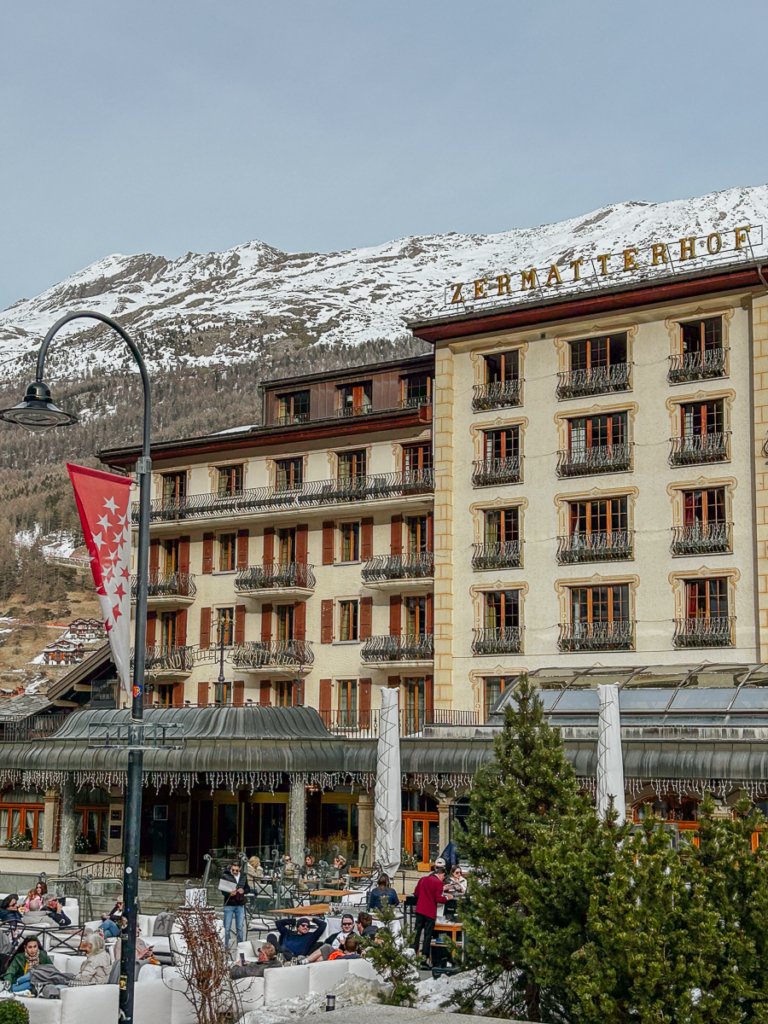
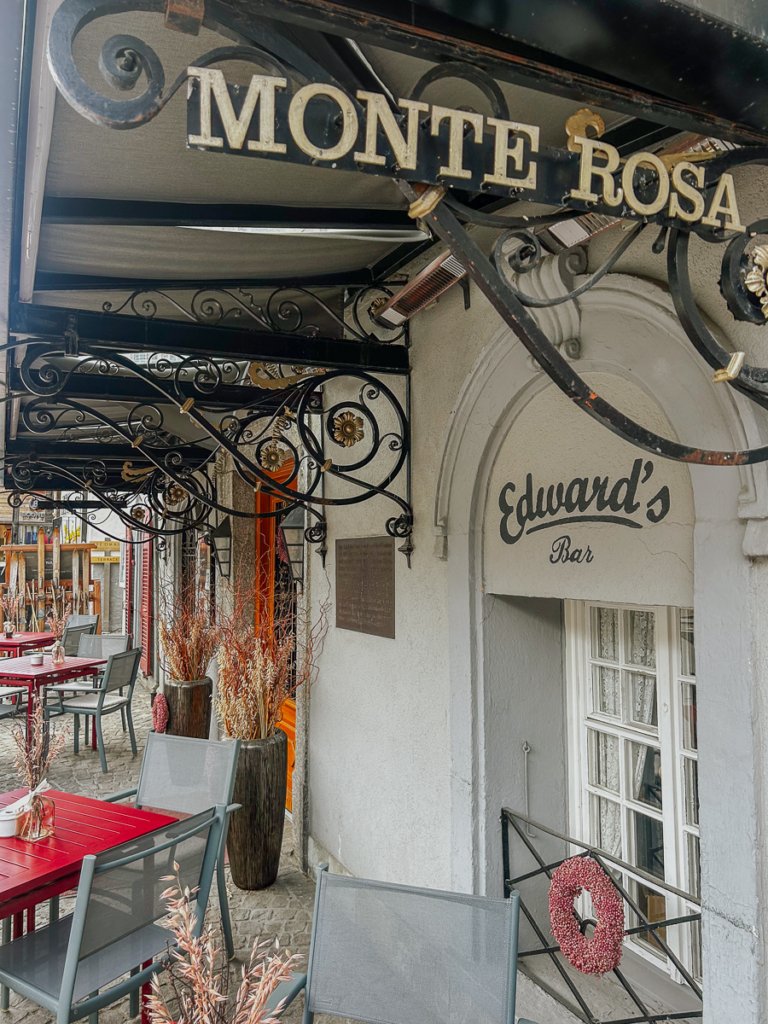
Can You Ski or Snowboard All of Zermatt in One Day?
Intermediate and advanced skiers and boarders could ski all three areas of Zermatt in one day, but you would be hard-pressed to manage every run, which wouldn’t include any of the linked pistes on the Italian side.
As the three areas are linked by either gondolas or pistes, starting early in the morning at either Sunnegga or Matterhorn Glacier Paradise, you could enjoy a portion of the pistes in each area.
Sunnegga is linked to Gornergrat by Piste 19, and the Hohtälli Gondola, and vice versa by Pistes 29 and 26, and the Gant chair lift. {Zermatt Piste Map}
Gornergrat and Matterhorn Glacier Paraside are linked by the Riffelberg Express between Riffelberg, Schweigmatten and Furi. You can ski from Gornergrat to Schweigmatten and board at the mid-station to Furi.
Vice versa, you can ski to Furi and ride the Riffelberg Express to Riffelberg.
Note: All lifts are subject to weather conditions, this may not be possible in inclement weather.
Is Two Days Enough in Zermatt?
Two days are enough to enjoy a good selection of Zermatt’s highlights, and it certainly offers a glimpse into its beauty and way of life. However, while two days provide a taste of Zermatt, you might find yourself longing for more time to fully immerse yourself in this exciting and beautiful destination.
Two-Day Zermatt Itinerary
If two days is all you have, let’s get that itinerary planned!
Use the detailed guide in the one-day itinerary for more information on each location or activity.
Following the same format as the one-day itinerary, choose how to pack your schedule based on the type of traveller you are. If you’re looking for a jam-packed schedule and want to see all the highlights of Zermatt, we suggest:
Day 1 | Matterhorn Glacier Paradise, Gornergrat & Zermatt Village
You could save some of the locations in Zermatt Village to visit later on day 2.
Day 2 | Sunnegga & Zermatt Village
During the summer, take your time to explore the 5 Lakes Trail or have a leisurely lunch at one of the Findeln restaurants. In winter, skiers and boarders should cruise around the pistes while soaking in that Matterhorn backdrop.
For the more leisurely travellers, choose one of the mountain areas with a lunch stop and stroll the village at your own pace later in the day.

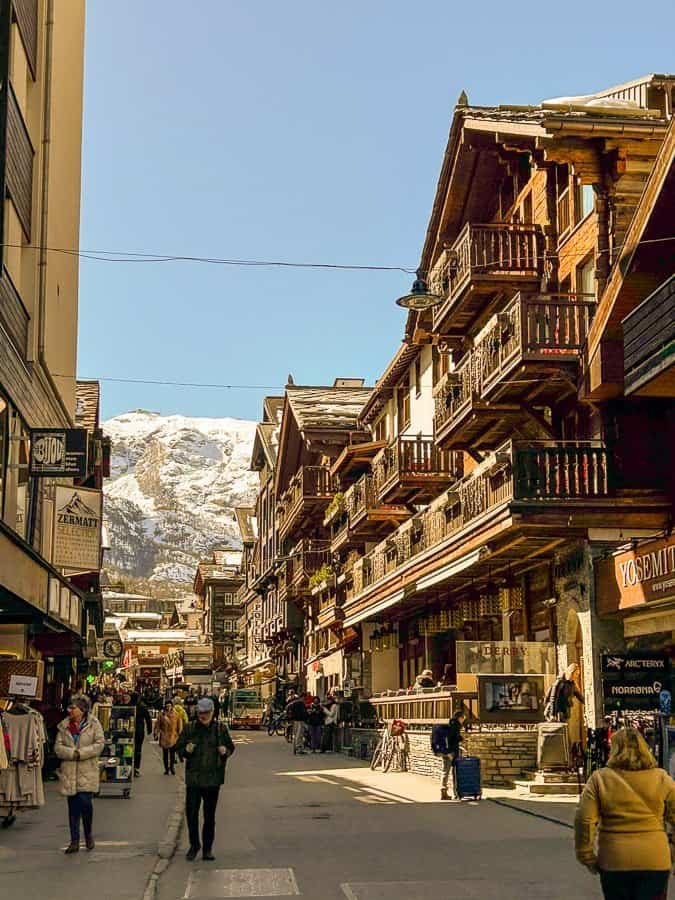
Three to Four Day Zermatt Itinerary
If you have three to four days, let’s take that pace down a notch, filling every hour and finding yourself exhausted by day three is not the one.
Use the detailed guide in the one-day itinerary for more information on each location or activity.
To make the most of your time, here’s our guide to putting together the best itinerary to visit Zermatt within four days:
Day 1
Zermatt Village
Arrive, breathe in that crisp mountain air, and take your time exploring Zermatt village. Head to Hinterdorfstrasse via Bahnhofstrasse. Stroll along cobblestone streets, pop into a coffee shop, inhale a freshly baked pastry, visit the chocolatiers–try not to buy everything in sight, browse the boutique stores and get your bearings.
Make your way into the village at night to taste one of Zermatt’s incredible culinary experiences.
Day 2
Matterhorn Glacier Paradise & Gornergrat
With a little more time on your hands than a one or two-day itinerary, you can spend more exploring the hiking and biking trails or pistes in these areas. Alternatively, you can break up the day with a lunch stop in between.
After exploring and a well-deserved long lunch, you may want to return to your accommodation to relax before venturing out for the evening. If your hotel offers spa facilities, why not treat yourself?

Day 3
Sunnegga
Take the Funicular to Sunnegga, the bubble to Blauherd and then the large gondola to Rothorn.
In summer, enjoy those panoramic views over Zermatt before heading back to Blauherd to start the 5 Lakes Trail or one of the many other routes in the area.
In winter, explore the many beginner to expert runs in this region, swing by Blue Lounge for a drink with a view, treat yourself to lunch in Findeln or stop by Adler Hitta for Deep House DJs and live musicians.
At the end of the day, get your party on at CERVO après ski.
Day 4
You lucky devil. 4 days is the optimum amount of time to squeeze in a lot of the goodness that Zermatt has to offer. With this extra day, you can add an exciting activity, explore a quieter region or pop over to Italy for lunch.
How exciting!
Here’s what we would do with a fourth day in Zermatt:
Paragliding

For the adventurous souls, souring over Zermatt in a tandem paraglide is an adrenaline rush combined with spectacular views at any time of the year. With highly qualified and experienced pilots, this is a bucket list activity suitable for children and adults.
With this being a short activity, you would still have plenty of time to fit in more sightseeing or adventure sports.
Breithorn
If it hasn’t already been squeezed into your itinerary, summiting this 4’164 m peak can be achieved in a few hours. It can be hiked or ski toured at any time of year if the conditions are good and you have the necessary experience, equipment and guidance.
Ride the Alpine Crossing to Italy
The Alpine Crossing from Zermatt to Cervinia is an unforgettable adventure that bridges the Swiss and Italian Alps. As you glide across the cableway, you’re treated to 360º views of towering snow-capped peaks, shimmering glaciers, and a different perspective of the Matterhorn.
Make a lunch stop at one of the many mountain restaurants in Cervina. Or ride the gondola to the base station and back for the views.
Summer
Choose one of these locations to explore during your summer visit:
Höhbalmen
As you look at the Matterhorn from Zermatt, that area on the hill to the right of you is called Höhbalmen, take the easy to moderate hike to the hamlet of Zmutt and indulge in a lunch break at Restaurant Z’Mutt.
Hikers looking for a challenge can make their way to Eidelweiss Mountain Hut or Trift Mountain Hut or create a circular route from Zermatt – Eidelweiss – Zmutt – Zermatt or vice versa.
One of our favourite hikes in this region is from Zermatt to Mettelhorn 3’406 m. This is a full day there and back again hike, with a small glacial crossing. For hikers experienced with crampons and glacial areas, this is a very rewarding hike, even though the last 100 m of ascent may have you questioning your life choices.
Hörnli Hutte

Get up close and personal with the Matterhorn by hiking to its base camp. The hike to Hörnli Hütte kicks off at the Schwarzsee cable car station (elevation 2,583 m), and it’s about 4 km of trail with a 740-meter elevation gain—so yeah, your legs are getting a workout.
The path starts off feeling pretty chill with some moderate uphill stretches, but then things get a little spicy with rocky terrain. Translation? Bring a good level of fitness, sturdy boots and maybe a sprinkle of determination.
The views of the Hörnli Ridge, the surrounding area and the Matterhorn up close are absolutely worth it.
Charles Kuonen Suspension Bridge
High up on the hill above Randa, the longest pedestrian suspension bridge in the Alps hangs 85 m up. Take the 20-minute train to Randa from Zermatt and then the circular route to the Charles Kuonen Suspension Bridge anti-clockwise, crossing the bridge and then descending via the forest.
The descent in this direction is much steeper, if you have bad knees, or would prefer a gentle descent, you could take the route clockwise or do a there and back again.
If you have time, swing by Schalisee Lake in Täsch, relax in a Schali Lago deckchair or have a go at wakeboarding.
Mountain Bikers can take the Matterhorn Valley Trail from Zermatt to Randa, hike to the Charles Kuonen Suspension Bridge and back, cycle to Schalisee Lake for a refreshing dip and then take the train back to Zermatt.
Winter

Skiers and Snowboarders should take this day to explore the pistes of Cervina and Valtournenche. One of the things I love the most about Zermatt, is the ability to say, “Oo should we pop over to Italy for lunch today?”.
You will find the pistes of Valtournenche much quieter than those in Cervinia and Zermatt. For lunch, stop at Chalet Etoile or Ristorante Bontadini. They can get busy, so make sure to book in advance.
At the end of the day, treat yourself to sundowners at Rifugio Teodulo. If you have time in your itinerary, consider spending a night here. Skiing into Cervinia as the sun rises, or 16 km back to Zermatt before the lifts open, is an extra special experience.
Where to Stay in Zermatt
Whether you’re visiting Zermatt for skiing, hiking, or a romantic getaway, there’s no shortage of charming places to stay. From affordable to luxurious, here are some of the best hotels in town:
Best Budget: Hotel Garni Testa Grigia
Bang for your buck with an excellent location.
Best Mid-Range: Unique Hotel Post
Various bars, restaurants and entertainment.
Best Luxury: BEAUSiTE Zermatt
Luxurious spa, dining experiences and Matterhorn views.
Tips to Maximise Your Trip
Zermatt is as magical as it is manageable—with the right planning, you can get even more out of your visit.
- Stay Overnight: Even if you only have one day in Zermatt, if possible, book an overnight stay to maximise your time, rather than a day trip. Zermatt is far down the valley and not close to many other locations.
- Pick the Right Accommodation: Look for hotels or chalets with a view of the Matterhorn. Yes, it is worth it. Bonus points if there’s a hot tub or pool with that view.
- Visit at the Right Time: Winter for snowsports, summer for hiking and biking. Shoulder seasons (spring and autumn) are quieter if you want fewer crowds but still plenty to see.
- Weather-Proof Your Plans: Alpine weather can be… temperamental. Bring layers, make flexible plans, and always have a backup idea for your day.
- Budget Like a Pro: Travelling via train for over four days and thinking about that Swiss Travel Pass? Get it. It’ll save you tons on trains, buses, and mountain funiculars. Also, multi-day passes for activities are a lifesaver.
- Zermatt is car-free: Remember this when planning your journey times or where to park your car in Täsch. The most convenient option is at the Täsch train station car park.
Closing Thoughts on 1 to 4 Days in Zermatt
Whether you’re gazing up at the Matterhorn or sinking into a sunny meadow after a long hike, Zermatt has a way of weaving itself into your memories. Its mix of adventure, beauty, and alpine wanderlust is just the right medicine for whatever ails your travel-hungry soul.
But here’s the real deal. Whether you’ve got two days, four days, or even a week, Zermatt has a little magic to offer everyone. Pack your sense of adventure, a warm jacket, and maybe a camera with lots of storage. Because once you’re standing in that alpine haven, time has a funny way of slipping by.
And trust me, you’ll leave ready to plan your next trip back. Because one does not simply experience Zermatt just once.
© Discover Zermatt, My Switzerland, Zermatt Tourismus.
Plan Your Perfect Trip to Zermatt
Ready to dive deeper into planning your visit?
Our essential guides help make the most of your time in the mountains.
Getting Here
Trains, transfers & travel tips
Where to Stay
The best hotels, chalets & apartments
What to Do
Skiing, hiking & year-round activities
Where to Eat
Restaurants, fondue & hidden gems
Zermatt FAQs
Everything you need to know